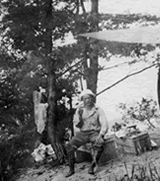
Father Julius A. Nieuwland’s renowned contribution to chemistry was his laboratory research on acetylene, which famously led to the invention of that durable synthetic rubber, neoprene, by DuPont developers in 1930. A successful Allied war effort and generations of better living through wetsuits, knee braces, clarinet “corks” and Halloween masks ensued.
Every bit as valuable to biologists and ecologists, however, is The American Midland Naturalist, the scientific periodical Nieuwland founded as a young professor of botany in 1909. Today the Midland, which has published classic papers in the life sciences while deftly adapting to rapid changes in research methods, technology and the categorization of disciplines, may be the best-kept secret among Notre Dame’s storied traditions.
That most Domers pass their student years without encountering the journal is ironic, given its influence within its field. JSTOR, a leading nonprofit online archive of scholarly publications, rates The American Midland Naturalist “among the most frequently cited journals in . . . ecology, mammalogy, herpetology, ornithology, ichthyology, parasitology, aquatic and invertebrate biology and other biological disciplines.”
Professor Theodor Just, who became Nieuwland’s first successor as editor in 1935, knew it already as a graduate student at the University of Vienna. Decades later, it was one of the first journals that Richard Jensen read as a graduate student in Tennessee. Now a Saint Mary’s College professor and 20-year member of the journal’s executive committee, Jensen says the publication, which has about 950 paid subscribers — mostly college libraries — and comes out four times a year, is must-reading for specialists in several fields. Government scientists, policymakers and instructors of general biology, especially at smaller schools, read it, too.
Jensen describes the Midland’s niche in an age of specialization as presenting comprehensive studies in biology and ecology that cut across disciplinary lines.
“The paper that deals with an aspect of the aquatic ecology of a particular stream would deal with insects, would deal with fishes, would deal with topics related to pollution, to human interference or human impact; would have to deal with the physiographical, geological influences on the stream bed itself. Papers in The American Midland Naturalist represent a rather broad view of biology,” he says.
Nieuwland launched the journal to provide a reliable outlet for students of “natural history,” Jensen says. At the time, this meant primarily descriptive field studies of plants and animals, their locations and behaviors. The plant-loving Holy Cross priest wanted especially to document the flora and fauna of the geographically “peculiar” Midwestern prairie.
Nieuwland labored zealously to ensure his journal thrived. He published dozens of papers in it and solicited manuscripts widely. He made and sold specimen slides to cover publication costs. And he traded issues to universities around the world in exchange for documented plant specimens the way boys trade baseball cards.
This last strategy cultivated an international readership. It also created a plant collection of invaluable breadth, still growing today, that boasts some 280,000 specimens housed in the Greene-Nieuwland Herbarium, part of the Museum of Biodiversity in the Jordan Hall of Science.
As the journal broadened its geographical scope, it became an important repository of research in “the new natural history” — the budding science of ecology — that studies relationships between organisms and their environment. Raymond Lindeman published foundational studies of Minnesota’s Cedar Creek Bog in the Midland before his death at age 27 in 1942. His work in the Midland and elsewhere established his influential concept of the flow of energy through food chains and enabled subsequent research into the destructive impact of insecticides and other pollutants in ecosystems.
Other authors in the Midland included Lucy Braun, who in 1950 became the first female president of the Ecological Society of America; Aldo Leopold, the father of U.S. wildlife management and author of A Sand County Almanac; and Theodosius Dobzhansky, a towering international figure in evolution and genetics.
More recent scientists, whose lasting contributions are still emerging, worked with an editorial team led by Notre Dame biology Professor Robert McIntosh, who held the editorship for 32 years until his retirement in 2002. McIntosh’s successor, Professor William Evans, added the journal’s subtitle “An International Journal of Ecology, Evolution and Environment,” and this year handed over the reins to Professor Hope Hollocher, its first female editor.
John Nagy is an associate editor of Notre Dame Magazine.
Photo of Father Niewuland at Lake Michigan, circa 1900, from Notre Dame Archives.